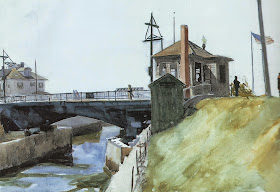Those of you who have been to Gloucester, MA, America’s
oldest seaport, (1623) know that Gloucester has a beautiful harbor. Champlain named it Le Beau Port as he
explored up and down the coast in 1606. The
Pilgrims landed in Plymouth in 1620 and soon came to Gloucester for summer
fishing. Along this waterfront land was
a narrow isthmus of connecting Cape Ann
to the mainland. But for his tiny piece
of land Gloucester would have been an island.
At an early date a canal was excavated by Rev. Blynman across this piece of land
allowing fishing vessels to pass from the harbor into Ipswich Bay. A bridge was built and today there is a very
active draw bridge facilitating the passage of boats. Named after this early minister, the formal
names are the Blynman Bridge and the Blynman Canal.
 |
| Edward Hopper's painting of the Blynman Bridge and the Blynman Canal with George O. Stacy's house in the background. |
The road along the harbor leads to the bridge over the
canal has long been called “the cut”; the
only link to the mainland until Route 128 and a large bridge built in the late
1940s provided a major access to this island city.
A few houses were built along the road to the bridge,
formerly called Canal Street and later Western Avenue, now called the Boulevard.
Eventually a summer hotel was built and gradually houses replaced
the rope walk along the edge of the water.
These houses stood shoulder to shoulder about half way toward the
Blynman bridge.
George O. Stacy was a hotel man and park
commissioner. He envisioned a beautiful
esplanade to be completed for the City’s three hundredth birthday celebration
in 1923. So beginning around 1920
occupants of the houses along the waterside agreed to vacate their houses most of
which were moved to surrounding streets and available lots. With little resistance the owners complied. All, that is, except for Lucy Low living in
the home of her recently deceased parents.
Lucy's mother, whose name was Lucy Clark Low born in 1838 acquired the land from her parents in 1865. Her husband, William Low, was a carpenter and perhaps he built the house about that time.
Lucy's name on her birth certificate was Lucy but later in life she called herself Lue E. Low on legal documents. What is more confusing is that there are two birth certificates for her. The first name is Lucy S. Taylor Low born Oct. 23, 1861. The second is for Lucy Estella Low born Oct. 24, 1861 one day later.
Lucy's mother, whose name was Lucy Clark Low born in 1838 acquired the land from her parents in 1865. Her husband, William Low, was a carpenter and perhaps he built the house about that time.
Lucy's name on her birth certificate was Lucy but later in life she called herself Lue E. Low on legal documents. What is more confusing is that there are two birth certificates for her. The first name is Lucy S. Taylor Low born Oct. 23, 1861. The second is for Lucy Estella Low born Oct. 24, 1861 one day later.
Lucy’s Victorian cottage house was not far from where
Gloucester’s famous “Man at the Wheel” statue now
stands looking out to sea. Lucy refused
to move but more particularly refused the low price she was offered
for her house. Soon Lucy’s house was the only one that was left standing and remained there all by itself.
Lucy did agree to move but she wanted to be
paid $13,000 dollars. She had the City
over a barrel. Finally Lucy was paid the exorbitant sum of $8000 and she left.
 |
| Devastation surrounds Lucy's house. (Cape Ann Museum Photo) |
But that was not the end of the story! Lucy went to the auction and bought back her
house for $800 and moved it to a piece of land a short distance away. She then took up residence in her old home
with a new address.
 |
| This may be Lucy's house minus the porch and rear addition and a lower foundation.. |
With the last house gone work proceeded on the new sea
wall and sculptor Leonard Craske completed the iconic statue that graces this
beautiful piece of land near where Lucy’s house once stood. It represents a Gloucester fisherman at the
wheel looking out over the beautiful harbor with the inscription, “They that go
down to the see in ships”
 |
| Gloucester's Fisherman's memorial with old house that remained on the other side of the street. |
George O. Stacy’s dream had come to fruition and that
stretch of Western Ave. is now called Stacy Boulevard in his honor.
Lucy Low was a seamstress. She apparently lived in her little house, the homestead of her parents and the only house she had ever lived in until her death which probably took place after 1940. |
| The above photo is from an old postcard. |




What a great story! Lucy Low was really something else! Never under estimate the power of a woman!!
ReplyDeleteIt is amazing how attractive, ample and comfortable the 1923 picture of the house looks, and (if indeed the same building) how it is reduced to a cramped, claustrophobic-looking cottage. (Of course, further changes certainly occurred after Lucy's time.)
ReplyDeletePeople involved in these 'holdout' situations can be warped by their fight over the money. I'll bet that $8000 is still inside the walls of that cottage!
--Jim